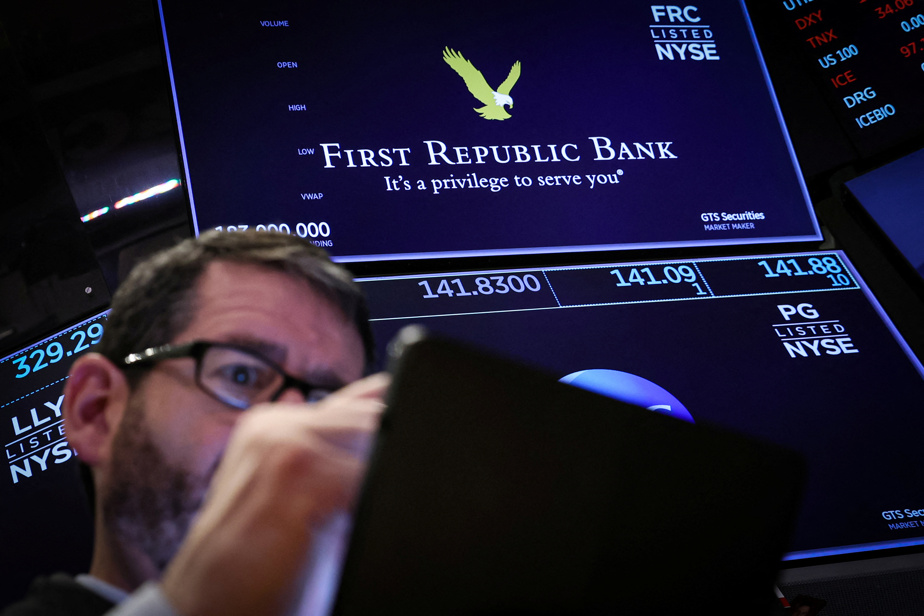Since the concerted intervention of the American authorities last weekend, why has calm not returned to the banking sector?
Regional banks (there are more than 4,000 in the United States) remain under pressure. The exodus of deposits continues despite assurances from leaders that the banking system is sound. Depositors, especially those with deposits over US$250,000, are withdrawing their money. Deposits of US$250,000 or less are insured by the American Deposit Insurance Corporation (FDIC for Federal Deposit Insurance Corporation). Reuters, quoting Goldman Sachs, says deposits have flowed out of US bank vaults into money market funds, very safe short-dated Treasury securities. For its part, the ABC network reported that Wells Fargo (1.7 trillion in assets, 4e largest U.S. bank) saw net deposits this week, likely from regional bank customers.
What happened from March 8?
Two regional banks, Silicon Valley Bank (SVB) in California and Signature Bank in New York, had to close their doors following a bank run. Customers rushed there to withdraw their money, and institutions ran out of funds. The FDIC took control of the banks. Last weekend, the Treasury, the FDIC and the Federal Reserve (Fed) agreed to cover all of the deposits of the two institutions (even those uninsured), and the Fed agreed to offer a credit facility by accepting as collateral for depressed assets like US government bonds. The crisis was caused by the steep rise in interest rates over the past year which caused the value of financial assets such as bonds to plummet. (Bond prices move inversely to interest rates.) During the pandemic, the SVB had bought a lot of US government bonds with money it received from its tech depositors. With bonds having lost value with rising interest rates, when depositors began demanding their money last week, there was a shortage in the vaults of both banks and word spread.
We were also worried about First Republic Bank of San Francisco. Where are we a week later?
On Thursday, First Republic received deposits of US$30 billion from 11 major financial institutions. With this money, she can reimburse her clients who claim their money without having to sell depressed assets like US government bonds. First Republic is a regional bank of comparable size to SVB, with which it shares the characteristic of having a concentrated base of middle-income customers.

PHOTO BRENDAN MCDERMID, REUTERS
Since March 8, 80% of First Republic Bank’s market valuation has evaporated.
So, any risk of a debacle has been ruled out?
Not according to the stock market. The action of First Republic Bank still lost 30% of its value on Friday. Since March 8, 80% of its market valuation has evaporated. “When an extreme event affects the financial system or a major economy, such as the collapse of the SVB, which rocked the US regional banking system and weighed on stock markets around the world, it usually takes more than a few days for markets to recover,” write Royal Bank economists Claire Fan and Carrie Freestone in a note to clients. The repercussions and volatility can last for weeks and spread to other geographies, as seen with the Credit Suisse setbacks.
What happened with Credit Suisse?
The institution founded in 1856 is grappling with issues that are specific to it and that are known to the market. Its stock has been under pressure since the start of 2021. further deteriorated, leading to a further fall in banking stocks and stock markets around the world, ”summarize the economists of the Royal. On Tuesday, Credit Suisse acknowledged “significant shortcomings” in its risk assessment. On Wednesday, the National Bank of Saudi Arabia, a major shareholder in Credit Suisse, rejected the idea of injecting capital. Credit Suisse’s main competitor, UBS, is in talks to buy its struggling rival, with the support of Swiss regulators, the report said on Friday. FinancialTimes.
Has the situation calmed down?
We will have to see. The title of Credit Suisse lost Friday 8% of its value on the New York Stock Exchange. “Investor concerns center on the viability of a proposed spin-off of the investment division to focus on its domestic and wealth management businesses,” reported The Telegraph from London.
What are the impacts of all this brouhaha for us?
The impacts are likely to be felt in the Fed’s monetary policy. In this regard, Desjardins Group’s analysis is hardly encouraging. ” [L]Policy makers have to admit: the story they told was wrong,” Royce Mendes, managing director and chief macro strategist, wrote in a note on Friday. “Instead of achieving its goal of price stability without disrupting markets and the economy, the Fed is now failing in two of its three terms. Inflation remains too high, and the financial system is now in trouble. Next week, the Fed will have the unenviable task of having to weigh both financial instability and excessive inflation. He sees an increase of 25 points in interest rates, just like Mathieu Marchand, independent economist from Quebec. “By pumping billions into American banks in the form of loans [300 milliards US en une semaine, a indiqué la Fed vendredi]the Fed is back to printing money again just when it has to fight inflation,” said Mr. Marchand.
